In the Moscow region, the soils are mostly clayey and acidic. They must be deoxidized, because nitrates accumulate in acidic soil. Aluminum and its salts in acidic soil take away potassium, calcium, magnesium, selenium, phosphorus, molybdenum and other trace elements, and plants starve and therefore their growth and development is delayed and even freezes. In the Moscow region, much more precipitation falls than is necessary for plant nutrition or evaporates. Many important elements are simply washed out, such as calcium and magnesium, which are not only necessary for plant nutrition, but also needed to neutralize the soil environment.
To get rid of the acidic environment, fertilizers with various calcium compounds Ca are used, in particular calcium carbonate (carbon dioxide CaCO₃). Advanced gardeners know that ash, slaked fluffy lime, chalk, crushed shell rock and dolomite flour can be used to deoxidize the soil. Today we will talk about the latter. Now you can safely buy dolomite flour in the departments for the garden and garden of supermarkets and garden centers, it is inexpensive. Sold in different packages from 1 kg, as well as in bulk.
What is dolomite flour?
- ground to powder rock dolomite, whose chemical formula is CaCO₃MgCO₃. This is a mineral fertilizer of natural origin, it is not additionally enriched with any other additives, but is used in its pure form for fruit and vegetable crops, flowers (including indoor ones). When using dolomite flour, the soil structure improves, acidity normalizes, weeds grow less, the activity of beneficial macro- and microorganisms is activated, plants are cleared of radionuclides.
Calcium and magnesium in dolomite flour are in carbonate form, they do not burn plant roots and soil living creatures. In addition, they accumulate in vegetables and fruits in small doses and do not harm human health. To apply dolomite flour, you need to know the acidity of the soil.
How to determine the acidity of the soil?
1.By the weeds. If plantain, wood lice, buttercup grow predominantly on the site, then the soil is acidic. Coltsfoot, wheatgrass, chamomile, clover, and dandelions prefer slightly acidic soil. Nettle and quinoa grow mainly on neutral soils. To be fair, it should be noted that modern weeds know how to adapt to any conditions and the same weeds can grow on soils with different acidity.
2.With the help of vinegar. This method was found by me on the Internet. A handful of garden soil is sprinkled with vinegar. If the soil begins to bubble and swell, then the acidity is neutral or acidic. The soil in our area is acidic, however, the vinegar did not give any reaction. Therefore, I consider this method unreliable.
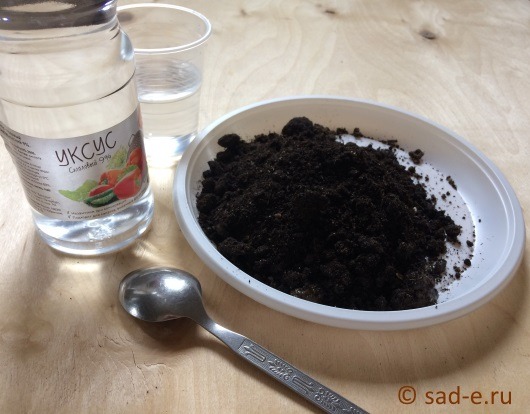
3.C using special devices or indicator strips. On sale there are measuring indicator strips or digital meters. You can even purchase 3 in 1 devices: to determine the acidity of the soil, humidity and light.
What plants do not need dolomite flour?
Plants that like or tolerate acidic soil do not need dolomite flour. Moreover, they do not do well in alkaline soils, which will have to be acidified. The most common are: and azaleas, heathers, magnolias, hydrangeas (,), lilies of the valley, tenacity, many ferns, camellias, most, Japanese quince, blueberries, cranberries, acacia, mosses, etc. Sorrel, radish prefer their vegetable crops to acidic soil, spinach, rhubarb. Slightly acidic - cucumbers and tomatoes. But, salads, asparagus and do not develop at all on acidic soils.
How to apply dolomite flour?
Since dolomite flour has a powdery structure, it is simply scattered superficially under mulch (peat, sand) or embedded in the soil. In order for the dolomite powder to be evenly sprayed, you can use a sieve and pour through it. You can do this throughout the garden period. annually. But it should be remembered that when applied in autumn and before winter, most of the dolomite flour will be washed out by rains and melting snow. Therefore, I recommend spring and until mid-summer.
In horticultural literature, you can often find recommendations to use liming once every 3-5 years. This practice comes from the Soviet times of collective farms and state farms, when lime was poured in large volumes without special equipment and then gradually washed out over 4-5 years until the soil was in a normal state. In private small plots these days, this practice is unacceptable. It is necessary to lime annually, observing the norms! under mulch (peat, sand). Under, lifting the leaves, scatter dolomite flour within a radius of 10-15 cm from the bush with rakes embedded in the soil.
Dolomite flour in spring or autumn is added directly to the prepared soil when planting, mixing together with other components (peat, sand).
Dolomite flour can also be added to compost heaps by layering. Already in March-April, it is added to the surface layer in greenhouses.
How to make a Mittlider mix #1? You need to take 5 kg of dolomite flour and 50 g of boric acid (sold in pharmacies) or borax. Which means the same as 3.5 liters of dolomite flour and 2 tablespoons of boric acid or borax. Everything should be evenly, slowly, so as not to dust, mix. It is convenient to mix with a rubber-gloved hand.
With high acidity, the clay becomes dense, does not allow air to pass through, which is so necessary for the respiration of the roots. When dolomite flour is introduced into such soil, it becomes looser, in the form of small lumps, between which air passes. Of course, other ingredients must be added to pure clay to improve the structure, such as peat, compost, sand, fine gravel, bark, humus, etc.
The manufacturer of dolomite flour gives such instructions for use:
acidic soil with a pH less than 4.5 contribute
– on soils with a light structure 350-450 g/m²
— with an average structure of 500-600 g/m²
— with a heavy structure 600-700 g/m²
Medium acid soil with pH = 4.5-5.2 contribute
– on soils with a light structure 300-350 g/m²
— with an average structure of 450-500 g/m²
— with a heavy structure 500-600 g/m²
slightly acidic soil with pH = 5.2-5.7 contribute
– on soils with a light structure 250-300 g/m²
— with an average structure of 350-450 g/m²
With a heavy structure 400-500 g/m²
The use of dolomite flour helps to strengthen the cell walls of plant roots, and this, in turn, makes it difficult for all kinds of root fungal and bacterial infections to penetrate. This means plants get more nutrients through healthy absorptive roots.
What can you mix dolomite flour with?
Dolomite flour is only compatible with boric acid and blue vitriol. All other fertilizers: azophoska, nitrophoska, ammonium nitrate, urea, superphosphate, ammonium sulfate, manure, should be applied two weeks after the application of dolomite flour.
I believe that along with, and, dolomite flour should be used in every garden near Moscow. Then the plants will always be healthy, and the harvest will be environmentally friendly.
Dolomite flour used as a magnesium fertilizer (20 g per 1 m 2) when digging and for liming acidic soils (from 150 to 300 g per 1 m 2). Dolomite flour is used for potatoes, cucumbers and tomatoes when grown in greenhouses.
Dolomite flour it can be natural and obtained by crushing and grinding limestone and dolomite (limestone (dolomitic) flour).
Dolomite natural flour.At a moisture content of not more than 12%, it contains 80% (or more) of carbonates in terms of CaCO 3 and consists of calcium and magnesium carbonates with various impurities. In terms of particle size distribution, it usually represents a mass of 50-70%< 0,25 мм и не менее 85 % < 5 мм. Это очень ценное известковое удобрение, которое благодаря содержащемуся магнию может быть гораздо эффективнее известняковой муки на почвах легкого гранулометрического состава.
Limestone (dolomitic) and dolomite flour. It is obtained by grinding dolomite, which contains 25-32% CaO and 14-21% MgO, and in terms of CaCO 3 - 79.7-110.8%. In Russia (in accordance with GOST 14050-78) limestone flour is produced in two classes and two varieties, and for each of them in dusty (humidity up to 1.5%) and slightly dusty (4-6% moisture) forms. The varieties differ in neutralizing capacity - grade I is not less than 88%, grade II is not less than 85% CaCO 3, and granulometric composition - the first class has a finer grinding than the second. Classes within varieties differ only in particle size distribution - the second class is finer grinding than the first, in fractions:< 0,25 мм на 5-10%, < 1 мм на 3-10%. Данные полевых опытов в среднем за пять лет, обобщенные в ВИУА, показали, что наиболее эффективна тонко размолотая (менее 0,25 мм) фракция известняковой муки. Снижение эффективности известняковой муки с изменением гранулометрического состава (увеличением содержания крупных частиц >0.25 mm) increases significantly in the transition from pure limestone to more dolomitic, i.e., with an increase in the hardness of the ground rocks.
Shelf-life Unlimited.
What gives the introduction of dolomite flour
- soil acidity neutralization;
- soil enrichment with calcium and magnesium;
- improvement of physical and chemical properties of soils and their structure;
- improving the efficiency of organic and mineral fertilizers(the number of available forms increases);
- the conditions for the vital activity of microorganisms useful for plants are improved (due to a decrease in acidity);
- radionuclides bind (environmental situation improves);
- negatively affects the chitinous cover of harmful insects.
The effectiveness of the use of dolomite flour
Dolomite flour is especially effective on sandy and sandy loamy soils poor in magnesium. When making full doses of dolomite flour, the negative effect of liming on potatoes and flax is absent or much less than when making full doses of other lime fertilizers. The quality of lime fertilizers is evaluated not only by the content of compounds that neutralize the acidity of the soil, it also depends on the fineness (fineness) of grinding. The finer the grinding of dolomite flour, the sooner and more fully it interacts with the soil, and the faster it neutralizes acidity. The effectiveness of dolomite flour increases with the simultaneous introduction of boric and copper microfertilizers (boric acid and copper sulphate).
The introduction of dolomite flour significantly increases the effectiveness of organic and mineral fertilizers. On acidic soils, after liming, the decomposition of organic fertilizers is accelerated, and the latter enhance the positive effect of lime on soil properties. With the joint application of lime and manure, it is possible to halve the dose of manure, while the effectiveness of mineral fertilizers will not decrease.
The efficiency of liming is largely affected by the uniformity of the distribution of lime fertilizers over the surface of the site and the quality of their mixing with the soil. When making full and half doses, the method of embedding dolomite flour should ensure the mixing of fertilizers at the depth of tillage.
Terms and methods of making dolomite flour
Dolomite flour is applied as in open ground, as well as in greenhouses and greenhouses. The frequency of application is once every 3-4 years.
All lime fertilizers have a long-term effect. The greatest effect of liming is manifested 2-3 years after their introduction, then the acidity of the soil begins to rise and it becomes necessary to re-liming. The process of soil acidification is accelerated by the introduction of high doses of physiologically acidic fertilizers (ammonium nitrate, etc.). Accordingly, the more often such fertilizers are used, the more often it is necessary to make dolomite flour. But this should be done only after a preliminary analysis of the acidity of the soil. The ratio of crops in soil acidity should also be taken into account, since some crops require more acidic soils, some less. Dolomite flour should be especially carefully used for houseplants, since the introduction of high doses without proper control is a common mistake of amateurs.
- Acidic soils (pH< 4,5) - 500-600 г/м 2
- Medium acid (pH 4.5-5.2) - 450-500 g / m 2
- Slightly acidic (pH 5.2-5.6) - 350-450 g / m 2
Under potatoes, tomatoes, dolomite flour is applied in the fall when digging the site. Under vegetable crops, especially cabbage, dolomite flour is applied before planting.
For stone fruit crops, an annual application of 1-2 kg per tree over the area of the near-stem circle after harvest is necessary. For blackcurrant, 0.5-1 kg is applied under a bush once every 2 years. Under gooseberries, cranberries, blueberries, sorrel, dolomite flour is not used.
Dolomite flour, as well as lime can't be mixed With ammonium nitrate, ammonium sulfate, urea, simple superphosphate, granular superphosphate, double, manure.
Literature
- Yagodin B.A. etc. Agrochemistry / Under. ed. B.A. Yagodina. - M.: Kolos, 2002 - 584 p., ill. (Textbook)
Composition and properties of dolomite flour
Dolomite flour is called crushed rock - dolomite. The chemical formula of the mineral: CaMg(CO2),. The main active ingredient in the application of dolomite flour to the soil is calcium. The displacement of calcium from the absorbing soil complex by hydrogen ions H' is the direct cause of the increase in the level of soil acidity and the deterioration of its physical and chemical properties. Therefore, on acidic soils, I maintain the balance of calcium and hydrogen ions! artificially, for which dolomite flour is used along with other means.
Advantages of dolomite flour
The most famous "deoxidizers" of soils: slaked lime, or "fluff", ash and dolomite flour. How is dolomite flour different from its "competitors"?
Fluffy lime is the most powerful remedy. Its chemical formula is Ca(OH).
In addition to the calcium ion, the substance contains a hydroxyl group (OH), so the neutralizing ability of lime is almost one and a half times higher than that of dolomite flour.
The activity and speed of lime lead to the fact that in the first time after its application, the plants do not absorb phosphorus well, so the "fluff" is applied ONLY in the fall in the off-season, so that by spring the chemical processes in the soil come into relative equilibrium.
Wood ash contains 30-60% calcium salts, but its exact composition is unpredictable. It depends on the type of trees, the composition of the soil where they grew, and even on whether the ash is obtained from the branches or the trunk. The amount of ash that needs to be applied to the soil to neutralize acidity is always conditional, it cannot be calculated without chemical analysis.
But in any case, ash per unit
the area needs about 2 times more than dolomite flour, and this amount is usually not found at hand. Therefore, ash is used more often as a valuable component of plant soils for indoor plants and seedlings, because in addition to calcium, it contains potassium, phosphorus, magnesium and trace elements.
Dolomite flour is now the most popular and convenient means of reducing soil acidity. Its consumption is lower than that of ash, and unlike lime, dolomite flour is added at any time. This makes life easier, because you do not need to resort to intricate schemes, but you can apply fertilizers and soil-improving components during spring cultivation, for example, before planting vegetables. Since dolomite flour is rich in magnesium, it is the best acid neutralizer for light soils where magnesium is always lacking.
The effect of dolomite flour on soil and plants
Dolomite flour is contraindicated for rhododendrons, blueberries and other acidophilic plants (preferring acidic soil). It is used to neutralize acidic soils when growing vegetables, fruit trees and shrubs, many flowers.
Improvement of soil structure. The effect of the use of “dolomite” is especially noticeable if the soil is also heavy: with high acidity, the clay becomes dense and viscous, and when dried, it cakes “into a brick”. Calcium contained in dolomite flour contributes to the coagulation of soil colloids, as a result, the soil structure improves: it takes the form of lumps, between which air penetrates to the roots.
Strong healthy roots.
By itself, improving the soil structure already contributes to better root growth, but calcium also strengthens the cell walls, making it difficult for root rot to penetrate tissues, increasing the viability of root hairs and, as a result, the use of nutrients by the plant. In addition, it creates a favorable environment for beneficial soil bacteria that protect the roots from pathogenic fungi.
Limestone and dolomite flour are not the same thing. The formula of limestone is CaCO3 (calcium carbonate), while dolomite contains a lot of magnesium. For soil improvement, dolomite flour is preferable.
On a note:
Often, under the lime in the soil, agronomists and soil scientists mean not only calcium hydroxide (Ca (OH) 2), but also all rocks containing calcium, the particles of which are part of the soil. The first is calcium carbonate (CaCO3). Also, soil liming in a broad sense refers to the introduction of any calcium-containing additives, and calcium-rich soils are called calcareous.
Below are other entries on the topic "How to do it yourself - to the householder!"
My experience as a gardener is 39 years, it seems that I already know and can do everything. But no! How many new and useful things I learned from readers
Many thanks to all those who share their secrets and observations.
My site is in the lowlands. This place used to be called the Snake Swamp. When my husband and I began to build a house, and he dug a hole for concrete pillars, there was pure peat at a depth of more than a meter. In order for something to grow on such land, we bought sand and brought it in for digging. Somehow we were offered a whole car of dolomite for a small fee, we took it and dragged it around the whole site. It was in the fall, and in the spring the neighbors scared us that now nothing would grow in our country - they say, we brought in a lot of this dolomite. Of course, we were upset, but still we planted potatoes, carrots, onions, cucumbers, tomatoes, beets and looked forward to seeing if there would be a result?
Surprisingly, that year we collected an excellent harvest of all vegetables! Apparently, the earth was so acidic that we did not overdo it with dolomite. From year to year we learned from our mistakes, but we never left without a harvest.
Many contribute quicklime, but it can be used for liming, but this lime material is dangerous to humans. Dust particles can cause burns to the skin, eyes, lungs. Therefore, with this substance you need to work in overalls. Do you need it?! It should also be borne in mind that particles of calcareous materials, the diameter of which is less than 1 mm, react with the soil. When slaking ordinary lime, such particles are unlikely to form.
If you still want to use quicklime, then the manufacturers offer only a building material that may not be suitable for soil neutralization purposes. In particular, the well-known holding "Zabudova" (settlement of Chist, Molodechno district) produces building lime quick-extinguishing calcium quick-extinguishing powder without additives of the third grade, GOST 9179-77.
But dolomite flour is just the most suitable for neutralizing acidic soil. It is a valuable calcareous material, since in addition to calcium it also contains magnesium, the role of which in plant nutrition can hardly be overestimated. Moreover, this is a relatively cheap fertilizer, which is sold in specialized stores in packaged form. Therefore, we strongly recommend that you use dolomite flour to neutralize the acidity of the soil.
As soon as the earth dries up, without delay we take up gardening. As our great-grandfathers said, to plow and harrow - not to drop a day! We dig, we fertilize, we prepare ridges. We encourage each other, we transplant seedlings. We share experience, we try to create a comfortable life for plants. We know that the quality of our work will grow into a harvest.
A spoonful of ash - for dad-gardener!
If beetroot did not grow well in your garden last season, and sorrel and rhubarb were very good, then most likely there is a problem with soil acidity. Time to help the garden! Before digging the beds, sprinkle the earth with lime. and even better - dolomite flour, because it contains not only calcium, which reduces the acidity of the soil, but also magnesium, without which plants cannot do without.
Each section has its own rules, of course. But usually for loam, a half-liter jar of 10 mg is enough. It is necessary to sprinkle evenly, dig with the turnover of the reservoir, break up clods, loosen with a rake. Reducing the acidity of the soil will create Better conditions in order for the roots to actively absorb nutrients, then the plants will develop well.
Wood ash very gently deoxidizes the soil. The dose is about a liter jar per 10 m2. There are many trace elements in the ashes. as well as potassium, which promotes the formation and growth of fruits, improves their taste. And potassium also strengthens the skin (cuticle) of the leaf, plants after feeding with ash are less damaged by pests and diseases. Especially loves turnip ash.
Thrifty summer residents try to use economically organic fertilizers. Organics are not distributed over the entire surface of the ridge, but they are applied locally, into the grooves when sowing seeds, into the holes when planting potatoes, cabbage seedlings, cucumbers, tomatoes, eggplants, etc.
The most valuable, according to the observations of practitioners, is not even humus, but half-ripe compost. that is, one in which plant residues are still noticeable, but they are very easily crushed, almost crumble during work. Such compost contains not only nutrients for garden crops, but also beneficial soil bacteria, and this is very important for improving the fertility of poorly cultivated or depleted lands.
Are you planting potatoes? At the bottom of the hole, pour a handful of semi-decomposed compost, a tablespoon wood ash, sprinkle with soil, lay the tuber with sprouts up and cover with earth. How deep to plant? From the back of the tuber to the surface of the beds should be 5-7 cm.
When planting seedlings of cabbage, lettuce, cucumbers, humus is also needed on the garden bed, and ash is no longer as important as for potatoes.
Dolomite flour is called crushed dolomite - a rock whose chemical formula looks like CaMg (CO2). This effective remedy to reduce the level of soil acidity, the main advantages of which include, first of all, affordable price and environmental friendliness. It is thanks to this that the fertilizer described in the article is very popular among owners of suburban areas.
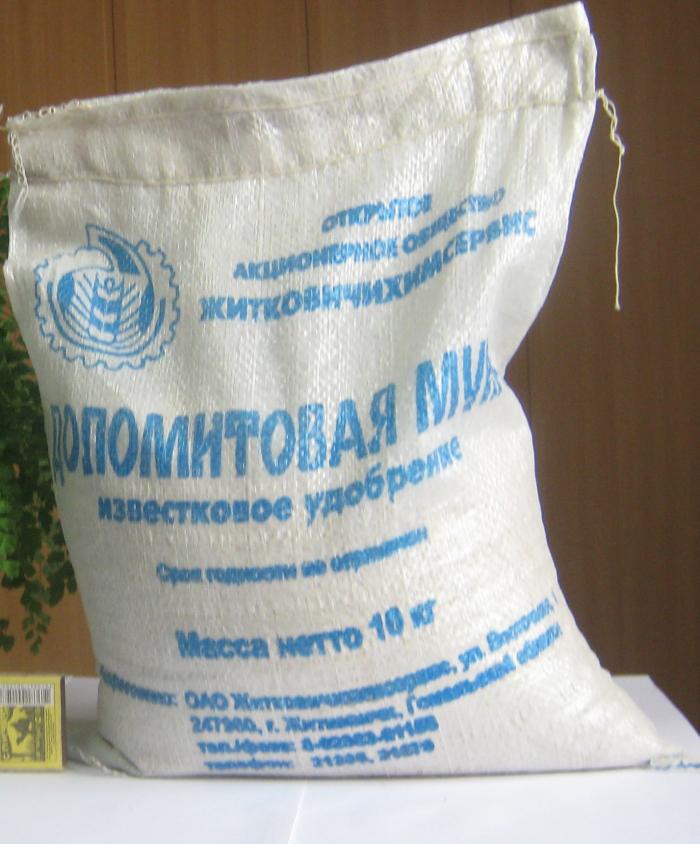
Features and advantages over other means
The use of dolomite flour is a convenient way to reduce the level of soil acidity. The substance is a crystalline mineral with a light color (gray or white, rarely reddish) and a characteristic luster.


A feature that distinguishes dolomite chips from other means of a similar action is not only a lower cost, but a much lower consumption. Moreover, slaked lime, for example, which contains a hydroxo group and a calcium ion, reduces the acidity of the soil too sharply, as a result of which plants, unable to get used to such conditions, begin to absorb phosphorus very slowly. That is why lime is applied only in the fall after harvesting - in this case, the soil will still have enough time to gain chemical equilibrium for the new gardening season.

Another powerful deacidifier is wood ash. The concentration of calcium salts in it - the main active substance - ranges from 30-60%, but the difficulty is that it is not possible to determine the exact composition. The concentration of calcium salts depends, first of all, on the rock from which the ash was produced, on which parts of the plants were used (branches, trunk, etc.), as well as on the characteristics of the soil and climate conditions in that region, where these trees grow. On their own, without resorting to chemical analysis, it is impossible to accurately determine the required amount of ash, which means that people act at random. By the way, ash is usually used for seedlings and flowerpots, because it contains a lot of phosphorus and potassium.

Note! The volume of ash or lime should be approximately twice as large as that of dolomite flour, subject to the same area.
How does dolomite affect the soil
In the described fertilizer, as noted above, a large percentage of calcium. If the soil is used for a long time for fruit plants, then over time it deteriorates. chemical characteristics, which means that the lost elements must somehow be replenished. The use of dolomite flour makes it possible to artificially maintain the required concentration of hydrogen and calcium ions.
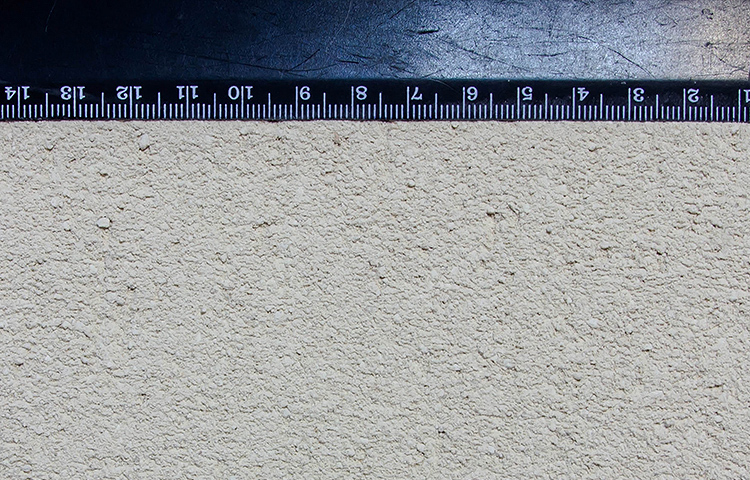
Penetrating into the soil, this fertilizer not only normalizes its acidity, but also enriches it with microelements necessary for plants. But when and how should fertilizer be applied? One of the differences between the mineral is its versatility: not only can you fertilize the site almost all year round, but flour also increases the yield of all crops: vegetables, fruits and grains. Finally, fertilizer efficiency is equally high in the garden, in the greenhouse and even in the house (if we are talking about indoor plants).
But it is especially effective on:
- sandy soil;
- soil with a low concentration of magnesium.
As for the soil with a neutral pH level, it is better not to use flour here, because this can cause a violation of the natural chemical balance.
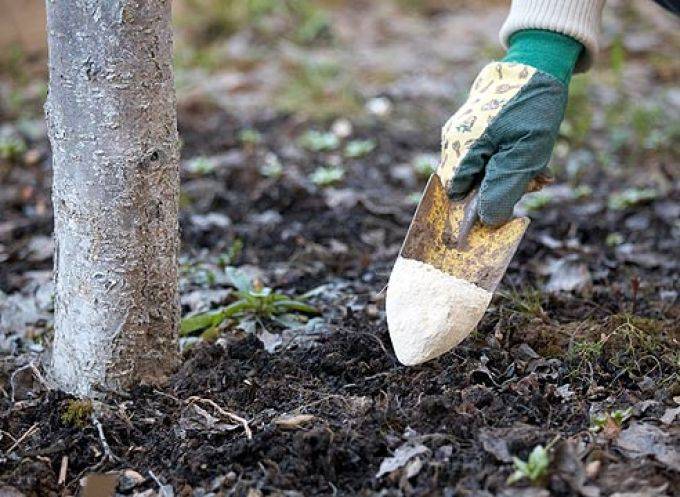
The fertilizer applied to the soil has the following effects:
- improves its biological characteristics;
- improves plant photosynthesis;
- increases the concentration of various minerals and trace elements that are necessary for plants;
- helps to bring out environmentally friendly products;
- increases the effectiveness of other means applied to the soil;
- improves productivity;
- improves the quality of nutrition of crops;
- finally, due to the presence of calcium in its composition, the flour activates the development of both ground and underground parts (rhizomes).
Note! In addition to all this, dolomite flour is excellent tool from harmful insects, while being completely non-toxic. Small particles of the product play the role of an irritating abrasive that destroys the chitinous shells of insects.
Video - Soil deoxidation with dolomite flour
Methods for determining acidity
In order to determine the right amount of fertilizer, you must first find out what the mechanical composition of the soil is (for example, clay or sandy) and its acidity level. Usually, disposable tests or other special devices (for example, the KS-300V soil analyzer) are used for this, which are sold in all gardening stores.

Acidity is expressed in pH, it is indicated by numbers from 0 to 14 and can be:
- weak (more than 7);
- neutral (pH is 7);
- high (less than 7).
By the way, it is possible to determine the acidity of the soil with the help of improvised means.
Determination of soil acidity by improvised means
Method number 1. Pour a small amount of table vinegar onto a handful of earth.
If as a result a violent reaction began with the formation of foam, then the earth is either neutral or non-acidic.

The absence of a reaction (the vinegar simply soaked into the soil) indicates that the acidity is increased.
Method number 2. In a glass of grape juice, you need to lower a lump of earth.
If the color of the contents changes, and bubbles form on the surface, then the soil is either neutral or slightly acidic.

Method number 3. Weeds will not grow in soil that is not suitable for them in terms of acidity. That is why they can be used as a kind of indicators indicating the level of pH.
On soil with low acidity, coltsfoot, clover and wheatgrass grow.

On soil with neutral acidity - nettle, quinoa.

If the acidity is high, then plantain and wood lice will grow on the site.
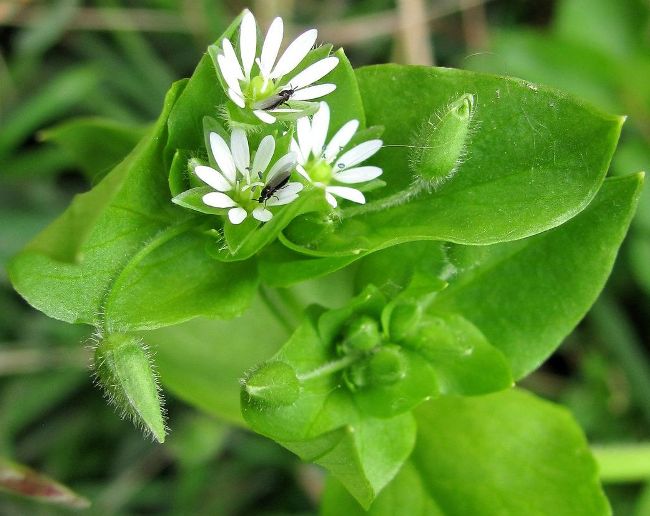
Note! The effectiveness of the fertilizer will increase markedly if you apply with it boric acid combined with copper sulphate.
Another useful video that can help in determining the properties of the soil before the deoxidation procedure.
Video - Folk methods for determining the pH level
Dolomite flour how to use in the garden
The specific proportions of the mineral depend on the level of acidity. So, approximately 0.6 kg / m? should be added to acidic soil, if it is slightly acidic, then no more than 0.35 kg / m?, and if neutral, then a maximum of 0.5 kg / m?. If the soil on the site is sandy, then the amount of flour should be reduced by one and a half times, and if it is clayey, it should be increased by about 15%.
Note! It is possible to increase the efficiency of fertilizer by distributing it as evenly as possible. If the flour is sprinkled correctly, then the benefits from it will be enough for about eight to ten years.
Do not forget that plants react differently to the application of the agent. In this regard, cultures can be divided into several groups.
Table. Groups of plants according to sensitivity to acidity
| Group | Short description |
|---|---|
| These plants include sainfoin, beets, alfalfa and cabbage. All of these plants are comfortable with a neutral or low level of acidity. You can increase the yield by applying the product to non-acidic soil. | |
| Onion, barley, wheat, clover, beans, soybeans, cucumbers and corn cannot grow on acidic soils. Ideally, such crops should be planted on soil with weak or neutral acidity. | |
| This group includes timothy, carrots, radishes, tomatoes, millet, buckwheat, and rye. All these plants grow equally well on soils with a pH level of 4 to 7.5. | |
| This includes potatoes and flax. For example, if you grow potatoes in acidic soil, then sooner or later it will become infected with scab, which will significantly reduce the level of starch in the tubers. Flax under such conditions will become infected with calcium chlorosis, which will lead to a deterioration in the quality of the fibers. |
When to fertilize?
As noted above, the described fertilizer can be used regardless of the season, since it does not affect either the composition of the soil or the intensity of absorption of other useful substances. But in most cases, flour is scattered before using other fertilizers, since it does not organically interact with all of them.
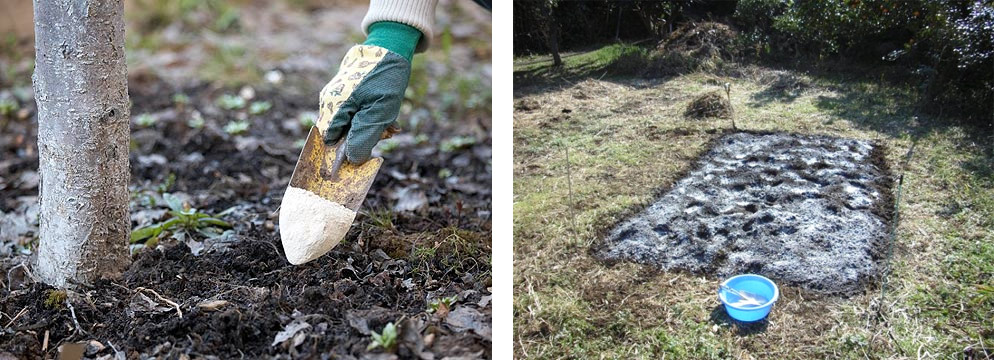
If vegetables are grown on the site, then dolomite flour crumbles in the spring, two to three weeks before planting. This tool not only nourishes, but also sanitizes the soil, which is especially important, for example, for potatoes prone to various diseases, whose development dolomite can stop. In addition, it is important for potatoes that the fertilizer fights pests. As for the feeding of closed crops, the introduction of the mineral in the greenhouse will prevent the spread of fungi.
In autumn, it is recommended to fertilize the soil for fruit bushes and trees. Here, about 2 kg of fertilizer must be applied under each tree (along the edge, with a slight depth), and for shrubs - from 0.5 kg to 1 kg (it all depends on size) in a similar way.
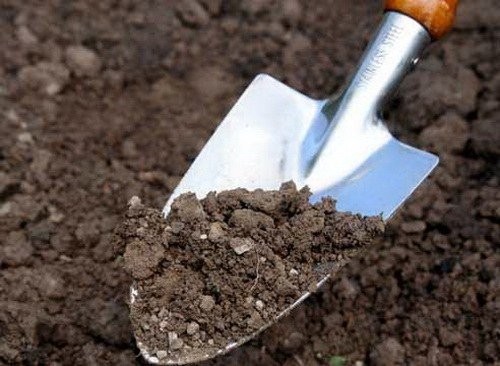
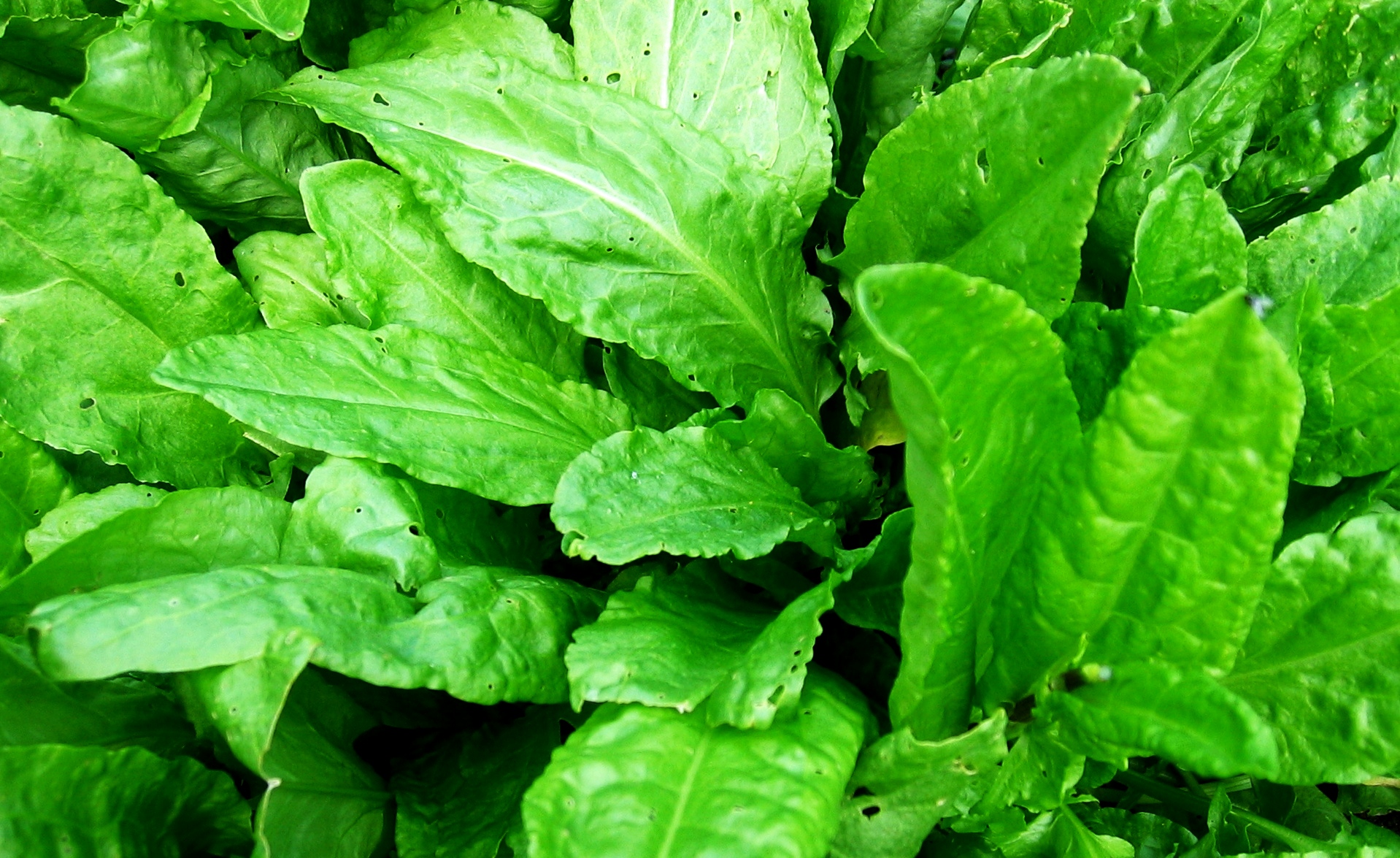
As a result, we note that dolomite flour acts gradually, so you should not expect an instant positive effect. The greatest benefit is observed two to three years after fertilization - the yield increases by 10-15%.
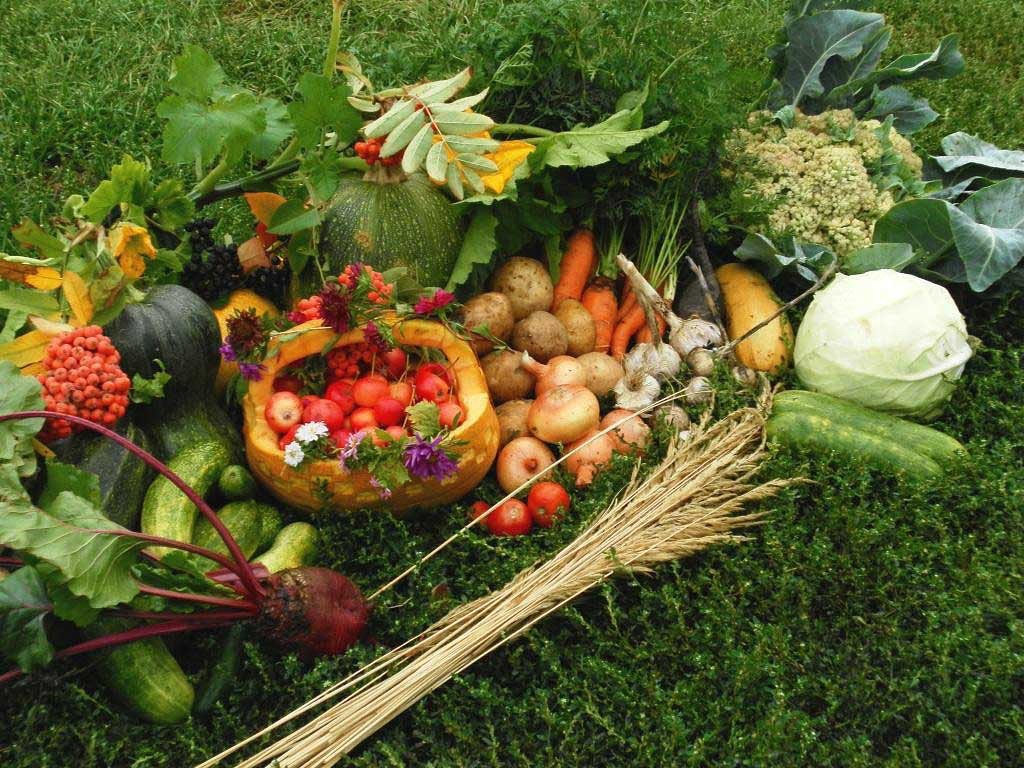
Dolomite flour is a finely ground rock used as a fertilizer. Raw materials for the manufacture of flour contain calcium and magnesium in large quantities. These minerals are essential for improving the physical and chemical properties of the soil. Calcium ions can artificially reduce the acidity of the soil. Dolomite formula: CaMg(CO2).
Dolomite is a rock.
Soils with high acidity are unsuitable for growing useful crops. Natural minerals help to improve the properties of the soil, change its composition. The composition of dolomite flour includes calcium and magnesium. Calcium favorably affects the root system of plants, reduces the acidity of the substrate. Magnesium takes part in photosynthesis.
Regular use of dolomite flour allows you to increase productivity, activate the growth of useful crops. With excessive acidity, the effect of other mineral fertilizers is neutralized. After the introduction of dolomite flour, the absorption of nutrients by plants improves.
We measure the acidity of the soil
In order not to cause harm, you need to know how to use lime fertilizer. Before applying it, it is necessary to check the acidity of the substrate. Based on the test results, it will become clear in what quantity to add dolomite flour, and whether it is worth doing. The easiest way to test soil acidity yourself is to test with litmus paper.
There are ways to approximately determine the acidity. Their use is advisable if litmus paper is not at hand. The simplest is to water the ground with vinegar. To do this, you need to take a small amount of soil from the garden, place it in a glass. Pour some table vinegar on top. If foam appears on the surface of the substrate, then the earth has a very low acidity. If the liquid is completely absorbed, then the earth is very acidic.
Determine the acidity garden plot You can by looking at the growing weeds. On acidic soils, woodlice and plantain take root well. Neutral soils are attractive to nettles and quinoa. Chamomile and dandelion grow well on an alkaline substrate. If some of these plants dominate the site, then you can understand whether the land needs dolomite.
Determine the amount of fertilizer
Having determined the acidity of the soil in the area, you can add flour. For increased acidity (pH less than 4.5), 500-600 grams per 1 sq.m. With an average value (pH 4.5-5.2), 450-500 grams per 1 sq.m. is enough. If the soil has a weak acidity (pH 5.2-5.6), then the amount of dolomite flour should not exceed 350-450 g per 1 sq.m.
With a neutral acidity value (pH 5.5-7.5), it is sometimes necessary to add mineral flour. It all depends on the crops that are planned to be planted on this site. It is impossible to increase the quantity too much per 1 sq.m., as the acidity can be greatly changed, and this will negatively affect the quality of the soil.
The manufacturer's packaging with fertilizers contains instructions for use. It is recommended to add acidity-changing flour to the soil no more than once every three years. It is best to do this in the fall, as the main components of the flour enter into a chemical reaction with the elements that make up the soil. All by spring chemical reactions stop, and the earth acquires the necessary qualities.

Factory packaging with crushed dolomite.
results
After the application of dolomite flour, physical and Chemical properties soil. The dolomite composition enriches the sandy soil with magnesium. As a result, the absorption of nutrients from the soil by plants is improved. The quality of the grown products increases, its safety improves.
The use of ground dolomite in the garden helps to neutralize slugs that can spoil most useful crops. The agent is not toxic, and the desired effect is achieved due to the structure of the flour. The smallest particles of calcium destroy the chitinous covers of pests, as a result of which the insects die.
It is useful to make dolomite flour under garden trees and shrubs. For stone fruit trees, the amount of fertilizer should be 1-2 kg. The introduced ground dolomite must be distributed around the shaft. It is not necessary to wait for the pre-winter period to fertilize trees. Soil enrichment with calcium can be performed immediately after harvest.
Blackcurrants and raspberries can be fertilized at the end of summer or autumn 1 time in 2 years. Under each bush, 0.5-1 kg of mineral must be added. The exact amount depends on the size of the bush and the frequency of fertilization.
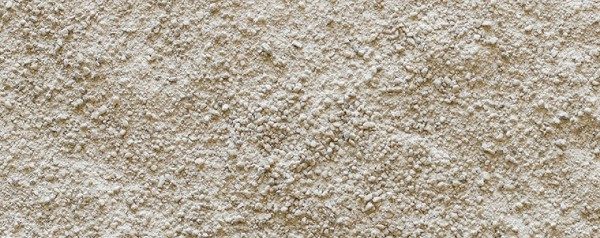
Flour ready for soil application.
Advantages
Limestone, charcoal and some other substances resemble dolomite flour in their properties. However, ground rock has advantages over other fertilizers. Its use contributes to the most rapid and accurate deoxidation of the soil. This result is difficult to achieve when using wood ash, since the amount of calcium in this substance varies and depends on many factors. Fluffy lime deoxidizes the substrate well, but its incorrect dosage can cause plant burns.
Every gardener who wants to increase his crop knows what dolomite flour is. There is a low price for this fertilizer in stores, so anyone can use ground dolomite for use on their site.

